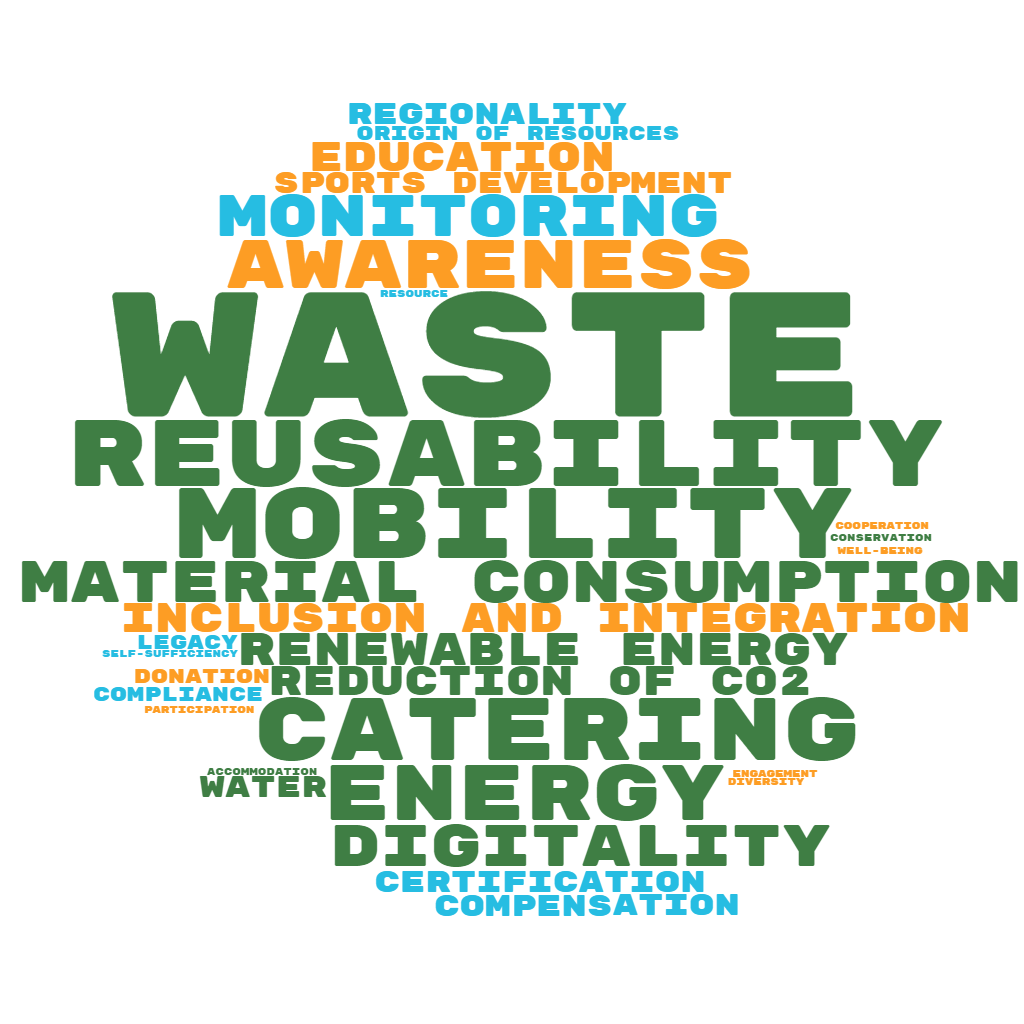
Survey on the sustainability performance of major sport events in Germany
As part of the project, the German Sport University Cologne conducted an online survey on the topic of “Sustainability performance of German sport events” in summer 2023. The organisers contacted were drawn from a database of major German sport events set up by the German Sport University. Relevant events were selected based on the following criteria:
– Number of spectators (from 50,000 or 200,000 per year regarding league events),
– Number of participants (from 20,000),
– Significance for the sport (continental and global).
450 relevant events were included in the database, although there was no claim to completeness. Once the contact details had been determined, a survey invitation was sent to the respective event organisers. 82 event organisers completed the survey. After the data was cleansed, 74 data records were used for the analysis.
The data set for the survey includes sport events of various types. The data shows a heterogeneous picture in terms of size (from 150 to 1,500,000 contributors; contributors mean spectators and accredited persons, including participants), duration (one-day to year-round; no data for 20-217 days), geographical level (regional to global), periodicity (one-off to league) and types of sport (31 different types of sport). This shows that the diversity of German sport events was covered by the survey, as can be seen in the figures.
74.3% of these organisations have integrated the topic of sustainability into their mission statement. Of these, 28.4% state that they have a comprehensive sustainability strategy based on objectives and measures. Another 55.4% stated that they had a partial sustainability strategy. Within the sustainability strategy, 62.2% orientate themselves on existing concepts or principles. Internal principles of the organisation and the UN’s Sustainable Development Goals were mentioned in particular. Around half of the organising committees have a full-time position that handles matters of sustainability. In 23.0% of cases, there is a sustainability department within the organising committee and in 16.2% of cases, sustainability is dealt with as a cross-cutting task of the committee. In addition, 55.4% of the events do not prepare a sustainability report, 31.1% exclusively after the event, 8.1% before and after the event, and only 1.4% exclusively before the event. These results are comparable to those of the sustainability strategy. For a further study, it would be interesting to find out why many people find it difficult to draw up sustainability strategies or reports.
Only a few of the respondents (17.6%) have themselves externally certified, while around half of those responsible for sustainability utilise external support (e.g. in implementation and reporting).
The survey participants were asked to indicate measures already implemented or planned that they consider important in the area of sustainability. They were asked to focus on the three most important ones. These are 48.7% in the area of “waste”, 46% in “transport”, 21.6% in “energy”, and 14.9% each in “material consumption” and “catering”. All of these measures can be assigned to the ecological dimension. This is consistent with the information on the subject areas in which sustainability performance was ultimately also implemented.
In the ecological dimension, 81.1% mentioned “waste” as a topic area, 71.6% “transport”, 67.6% “energy” and 66.2% “material consumption”. In the social dimension, “sports development” (66.2%), “health” (58.1%) and “diversity” (56.8%) were the most frequently named topics. In the economic dimension, “financing” (51.4%), “origin of resources” (44.6%) and “compliance” (41.9%) were rated as the most relevant. It can be seen here that the ecological area is mentioned more frequently than the social and economic areas. The charts show the areas in which sustainability efforts were made and the areas in which the three most important measures for dealing with sustainability issues can be found.
Further analyses revealed that events with a comparatively large number of contributors are more likely to have a sustainability position on the organising committee than events with fewer contributors. In this case, 81.25% of those responsible for events with over 100,000 contributors stated that there was a full-time sustainability position. What is remarkable in this case is that there are comparatively few sustainability positions in the range between 3,001 and 10,000 contributors. Here, only 20.0% stated that they had a full-time sustainability office. A further comparison showed that the topic of “energy” is very relevant for league organisations. Here, 89.66% of those responsible stated that they pursue the topic of “energy” as part of their sustainability ambitions. In addition, the topic of “waste” is more relevant for events with a supporting programme than for events without a supporting programme. 81.67% of those responsible for events with a supporting programme stated that they pursue the topic of “waste” as part of their sustainability ambitions. However, no correlation was found between the availability of various resources (budget, time, personnel and expertise) and the type of event (size of the event, type of sport, periodicity or geographical level).
The survey has limitations in some areas. The survey participants had a different understanding of the numbers of participants and spectators. In addition, missing information was entered retrospectively through research or subsequent editing.
To summarise, a strong focus on the ecological dimension of sustainability can be observed. The study demonstrates great commitment to sustainability; the direction in which the organisers are moving is promising. We would like to thank the numerous respondents for their participation and support in the survey.













